Employment Law Essay: Workers, Employees, and Independent Contractors
VerifiedAdded on 2022/08/27
|9
|2472
|18
Essay
AI Summary
This essay provides a critical evaluation of employment law, focusing on the distinctions between employees, workers, and independent contractors. It examines the legal framework governing the relationship between employers and employees, highlighting the significance of contractual agreements and the potential complexities in identifying employee status, particularly in relation to independent contractors. The paper discusses key legislation such as the Employment Rights Act 1996, the Trade Union and Labour Relations Act 1992, and the Employment Relations Act 1999 and 2004, along with relevant case laws, to analyze the evolving interpretations of employment relationships. It explores tests like the control test, the integration test, and the mutuality of obligation test, and the multi-factor test, used by courts to determine employment status, alongside the implications for both employers and employees, with a particular focus on the shift towards independent contractors and the statutory protections afforded to employees. The essay concludes by emphasizing the importance of clear legal guidelines and the need for courts to apply these rules effectively in determining the status of workers and the corresponding rights and obligations.
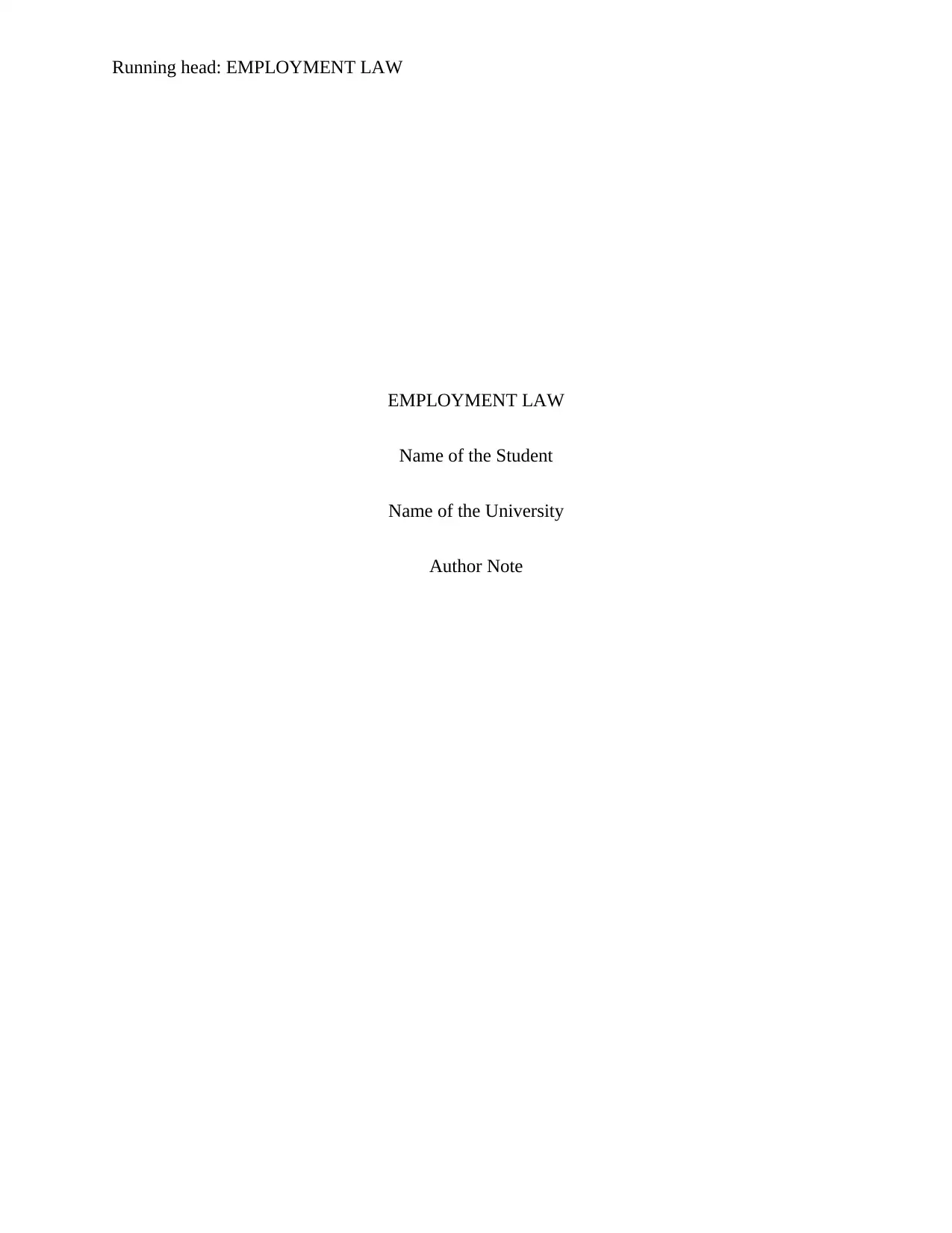
Running head: EMPLOYMENT LAW
EMPLOYMENT LAW
Name of the Student
Name of the University
Author Note
EMPLOYMENT LAW
Name of the Student
Name of the University
Author Note
Paraphrase This Document
Need a fresh take? Get an instant paraphrase of this document with our AI Paraphraser
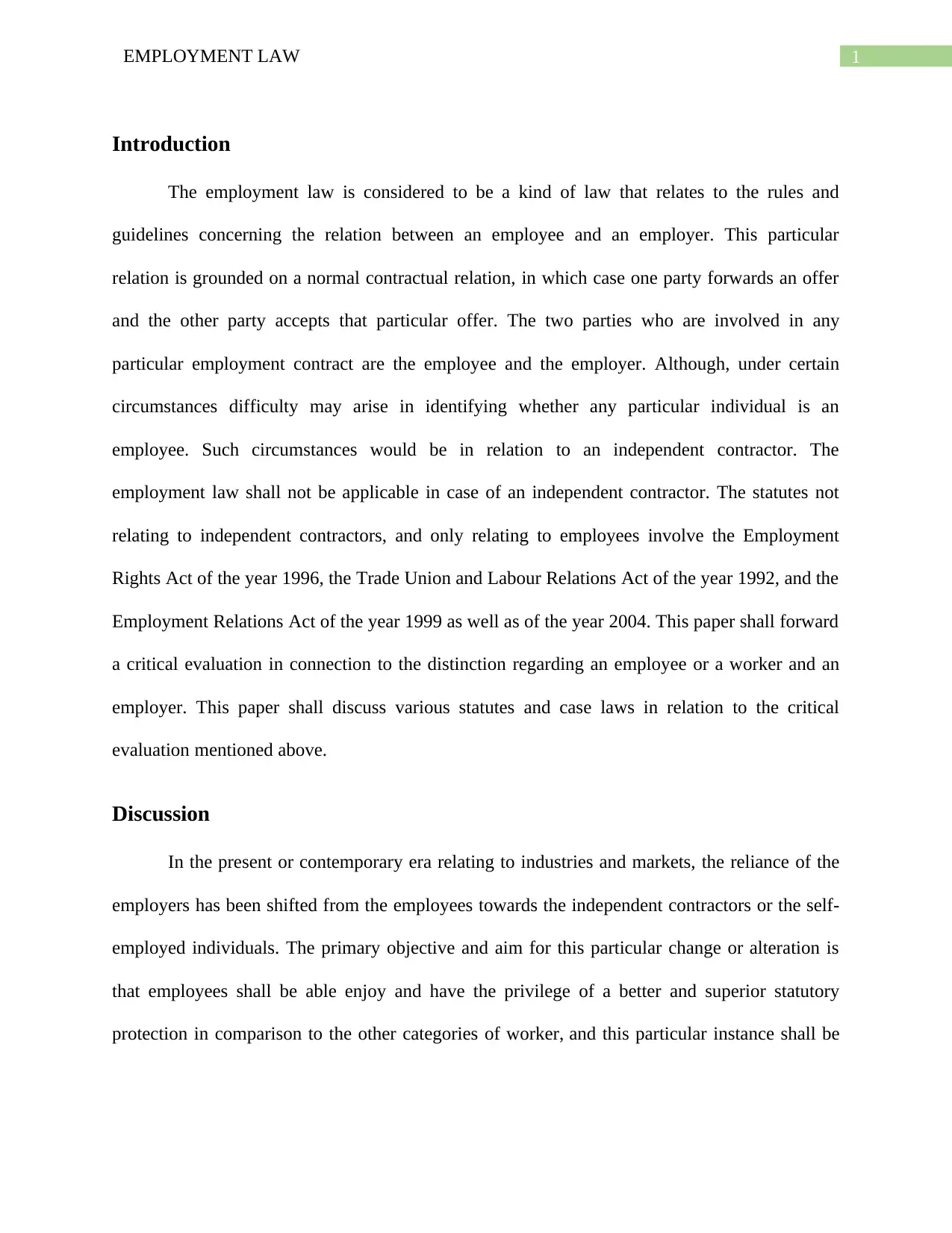
1EMPLOYMENT LAW
Introduction
The employment law is considered to be a kind of law that relates to the rules and
guidelines concerning the relation between an employee and an employer. This particular
relation is grounded on a normal contractual relation, in which case one party forwards an offer
and the other party accepts that particular offer. The two parties who are involved in any
particular employment contract are the employee and the employer. Although, under certain
circumstances difficulty may arise in identifying whether any particular individual is an
employee. Such circumstances would be in relation to an independent contractor. The
employment law shall not be applicable in case of an independent contractor. The statutes not
relating to independent contractors, and only relating to employees involve the Employment
Rights Act of the year 1996, the Trade Union and Labour Relations Act of the year 1992, and the
Employment Relations Act of the year 1999 as well as of the year 2004. This paper shall forward
a critical evaluation in connection to the distinction regarding an employee or a worker and an
employer. This paper shall discuss various statutes and case laws in relation to the critical
evaluation mentioned above.
Discussion
In the present or contemporary era relating to industries and markets, the reliance of the
employers has been shifted from the employees towards the independent contractors or the self-
employed individuals. The primary objective and aim for this particular change or alteration is
that employees shall be able enjoy and have the privilege of a better and superior statutory
protection in comparison to the other categories of worker, and this particular instance shall be
Introduction
The employment law is considered to be a kind of law that relates to the rules and
guidelines concerning the relation between an employee and an employer. This particular
relation is grounded on a normal contractual relation, in which case one party forwards an offer
and the other party accepts that particular offer. The two parties who are involved in any
particular employment contract are the employee and the employer. Although, under certain
circumstances difficulty may arise in identifying whether any particular individual is an
employee. Such circumstances would be in relation to an independent contractor. The
employment law shall not be applicable in case of an independent contractor. The statutes not
relating to independent contractors, and only relating to employees involve the Employment
Rights Act of the year 1996, the Trade Union and Labour Relations Act of the year 1992, and the
Employment Relations Act of the year 1999 as well as of the year 2004. This paper shall forward
a critical evaluation in connection to the distinction regarding an employee or a worker and an
employer. This paper shall discuss various statutes and case laws in relation to the critical
evaluation mentioned above.
Discussion
In the present or contemporary era relating to industries and markets, the reliance of the
employers has been shifted from the employees towards the independent contractors or the self-
employed individuals. The primary objective and aim for this particular change or alteration is
that employees shall be able enjoy and have the privilege of a better and superior statutory
protection in comparison to the other categories of worker, and this particular instance shall be
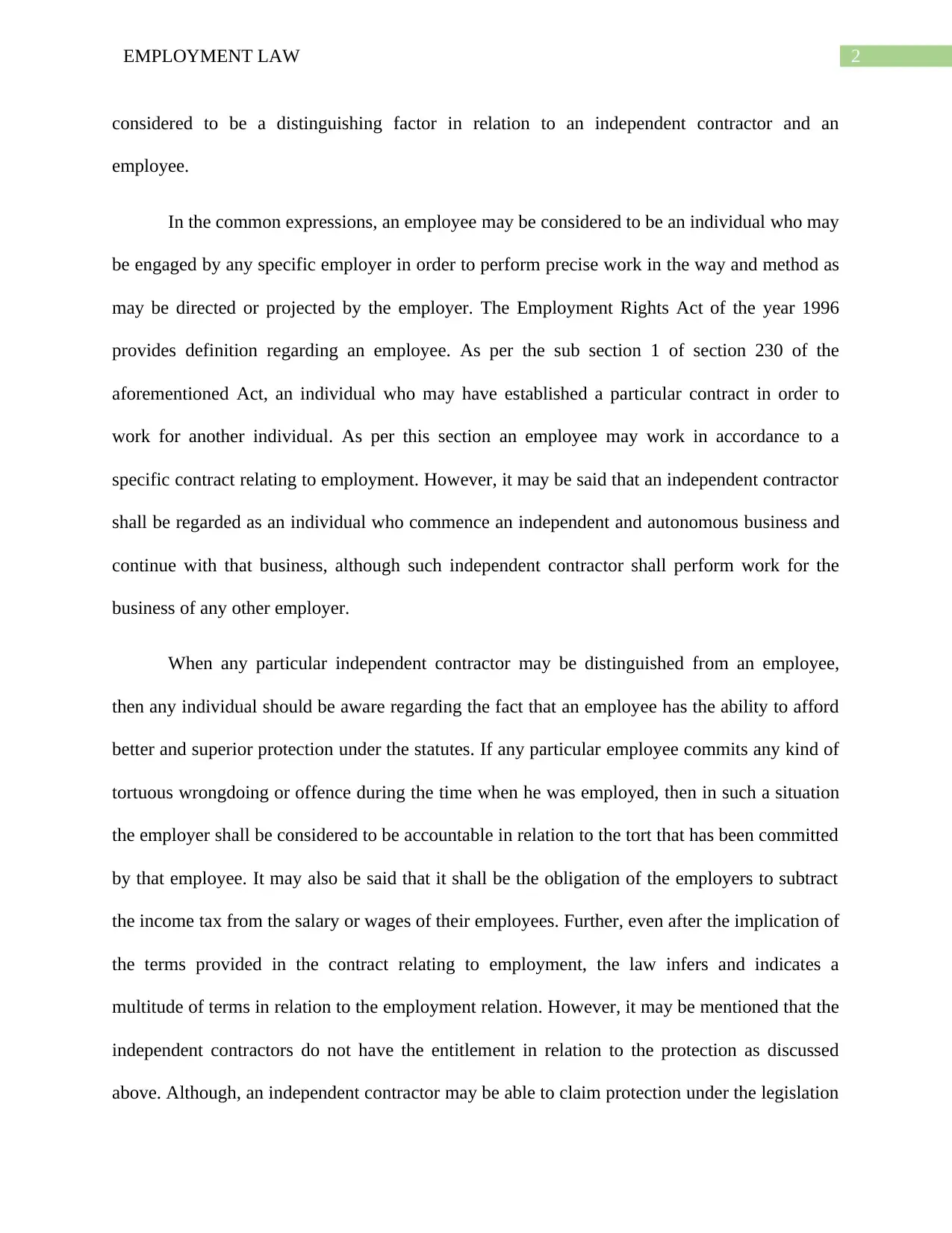
2EMPLOYMENT LAW
considered to be a distinguishing factor in relation to an independent contractor and an
employee.
In the common expressions, an employee may be considered to be an individual who may
be engaged by any specific employer in order to perform precise work in the way and method as
may be directed or projected by the employer. The Employment Rights Act of the year 1996
provides definition regarding an employee. As per the sub section 1 of section 230 of the
aforementioned Act, an individual who may have established a particular contract in order to
work for another individual. As per this section an employee may work in accordance to a
specific contract relating to employment. However, it may be said that an independent contractor
shall be regarded as an individual who commence an independent and autonomous business and
continue with that business, although such independent contractor shall perform work for the
business of any other employer.
When any particular independent contractor may be distinguished from an employee,
then any individual should be aware regarding the fact that an employee has the ability to afford
better and superior protection under the statutes. If any particular employee commits any kind of
tortuous wrongdoing or offence during the time when he was employed, then in such a situation
the employer shall be considered to be accountable in relation to the tort that has been committed
by that employee. It may also be said that it shall be the obligation of the employers to subtract
the income tax from the salary or wages of their employees. Further, even after the implication of
the terms provided in the contract relating to employment, the law infers and indicates a
multitude of terms in relation to the employment relation. However, it may be mentioned that the
independent contractors do not have the entitlement in relation to the protection as discussed
above. Although, an independent contractor may be able to claim protection under the legislation
considered to be a distinguishing factor in relation to an independent contractor and an
employee.
In the common expressions, an employee may be considered to be an individual who may
be engaged by any specific employer in order to perform precise work in the way and method as
may be directed or projected by the employer. The Employment Rights Act of the year 1996
provides definition regarding an employee. As per the sub section 1 of section 230 of the
aforementioned Act, an individual who may have established a particular contract in order to
work for another individual. As per this section an employee may work in accordance to a
specific contract relating to employment. However, it may be said that an independent contractor
shall be regarded as an individual who commence an independent and autonomous business and
continue with that business, although such independent contractor shall perform work for the
business of any other employer.
When any particular independent contractor may be distinguished from an employee,
then any individual should be aware regarding the fact that an employee has the ability to afford
better and superior protection under the statutes. If any particular employee commits any kind of
tortuous wrongdoing or offence during the time when he was employed, then in such a situation
the employer shall be considered to be accountable in relation to the tort that has been committed
by that employee. It may also be said that it shall be the obligation of the employers to subtract
the income tax from the salary or wages of their employees. Further, even after the implication of
the terms provided in the contract relating to employment, the law infers and indicates a
multitude of terms in relation to the employment relation. However, it may be mentioned that the
independent contractors do not have the entitlement in relation to the protection as discussed
above. Although, an independent contractor may be able to claim protection under the legislation
⊘ This is a preview!⊘
Do you want full access?
Subscribe today to unlock all pages.

Trusted by 1+ million students worldwide
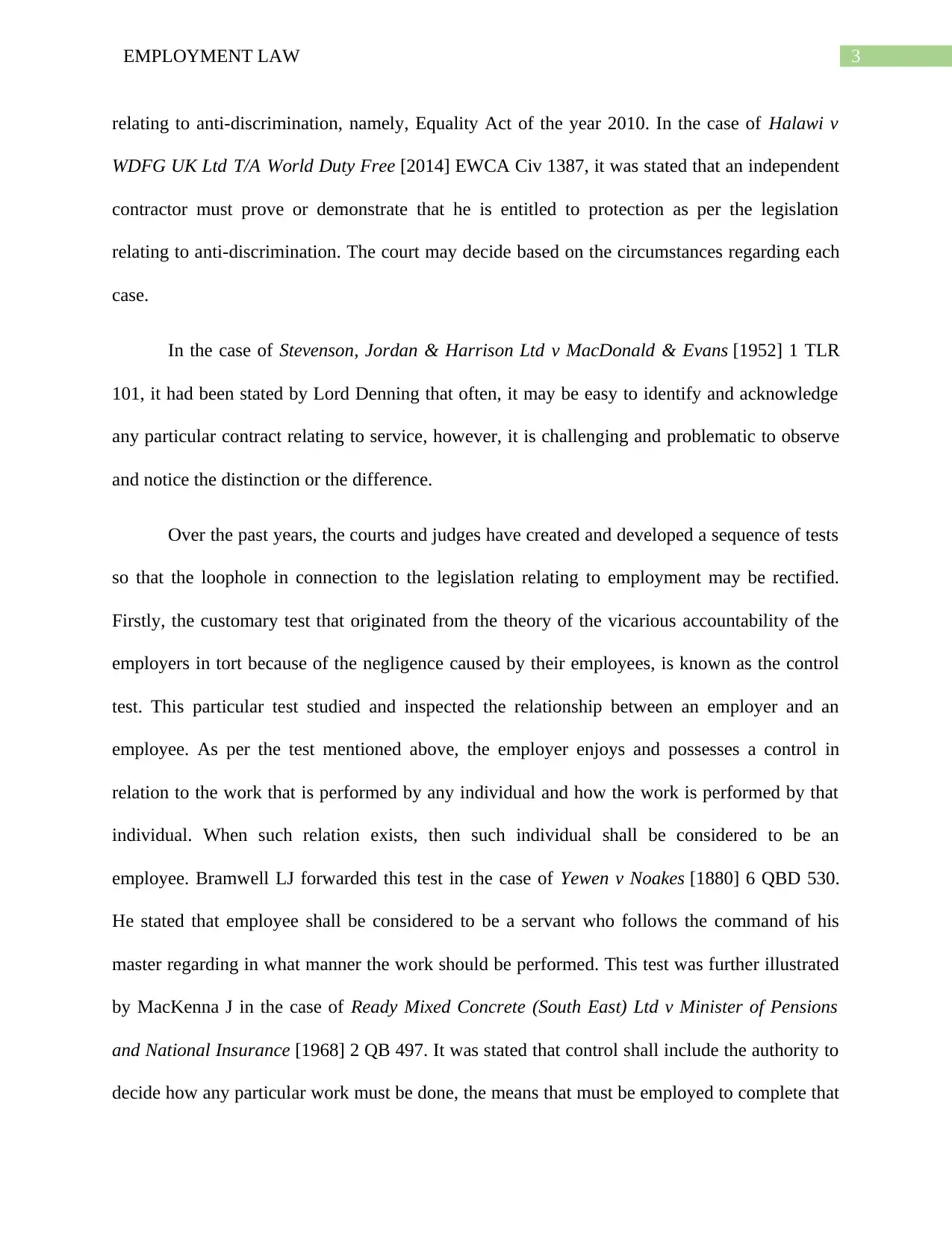
3EMPLOYMENT LAW
relating to anti-discrimination, namely, Equality Act of the year 2010. In the case of Halawi v
WDFG UK Ltd T/A World Duty Free [2014] EWCA Civ 1387, it was stated that an independent
contractor must prove or demonstrate that he is entitled to protection as per the legislation
relating to anti-discrimination. The court may decide based on the circumstances regarding each
case.
In the case of Stevenson, Jordan & Harrison Ltd v MacDonald & Evans [1952] 1 TLR
101, it had been stated by Lord Denning that often, it may be easy to identify and acknowledge
any particular contract relating to service, however, it is challenging and problematic to observe
and notice the distinction or the difference.
Over the past years, the courts and judges have created and developed a sequence of tests
so that the loophole in connection to the legislation relating to employment may be rectified.
Firstly, the customary test that originated from the theory of the vicarious accountability of the
employers in tort because of the negligence caused by their employees, is known as the control
test. This particular test studied and inspected the relationship between an employer and an
employee. As per the test mentioned above, the employer enjoys and possesses a control in
relation to the work that is performed by any individual and how the work is performed by that
individual. When such relation exists, then such individual shall be considered to be an
employee. Bramwell LJ forwarded this test in the case of Yewen v Noakes [1880] 6 QBD 530.
He stated that employee shall be considered to be a servant who follows the command of his
master regarding in what manner the work should be performed. This test was further illustrated
by MacKenna J in the case of Ready Mixed Concrete (South East) Ltd v Minister of Pensions
and National Insurance [1968] 2 QB 497. It was stated that control shall include the authority to
decide how any particular work must be done, the means that must be employed to complete that
relating to anti-discrimination, namely, Equality Act of the year 2010. In the case of Halawi v
WDFG UK Ltd T/A World Duty Free [2014] EWCA Civ 1387, it was stated that an independent
contractor must prove or demonstrate that he is entitled to protection as per the legislation
relating to anti-discrimination. The court may decide based on the circumstances regarding each
case.
In the case of Stevenson, Jordan & Harrison Ltd v MacDonald & Evans [1952] 1 TLR
101, it had been stated by Lord Denning that often, it may be easy to identify and acknowledge
any particular contract relating to service, however, it is challenging and problematic to observe
and notice the distinction or the difference.
Over the past years, the courts and judges have created and developed a sequence of tests
so that the loophole in connection to the legislation relating to employment may be rectified.
Firstly, the customary test that originated from the theory of the vicarious accountability of the
employers in tort because of the negligence caused by their employees, is known as the control
test. This particular test studied and inspected the relationship between an employer and an
employee. As per the test mentioned above, the employer enjoys and possesses a control in
relation to the work that is performed by any individual and how the work is performed by that
individual. When such relation exists, then such individual shall be considered to be an
employee. Bramwell LJ forwarded this test in the case of Yewen v Noakes [1880] 6 QBD 530.
He stated that employee shall be considered to be a servant who follows the command of his
master regarding in what manner the work should be performed. This test was further illustrated
by MacKenna J in the case of Ready Mixed Concrete (South East) Ltd v Minister of Pensions
and National Insurance [1968] 2 QB 497. It was stated that control shall include the authority to
decide how any particular work must be done, the means that must be employed to complete that
Paraphrase This Document
Need a fresh take? Get an instant paraphrase of this document with our AI Paraphraser
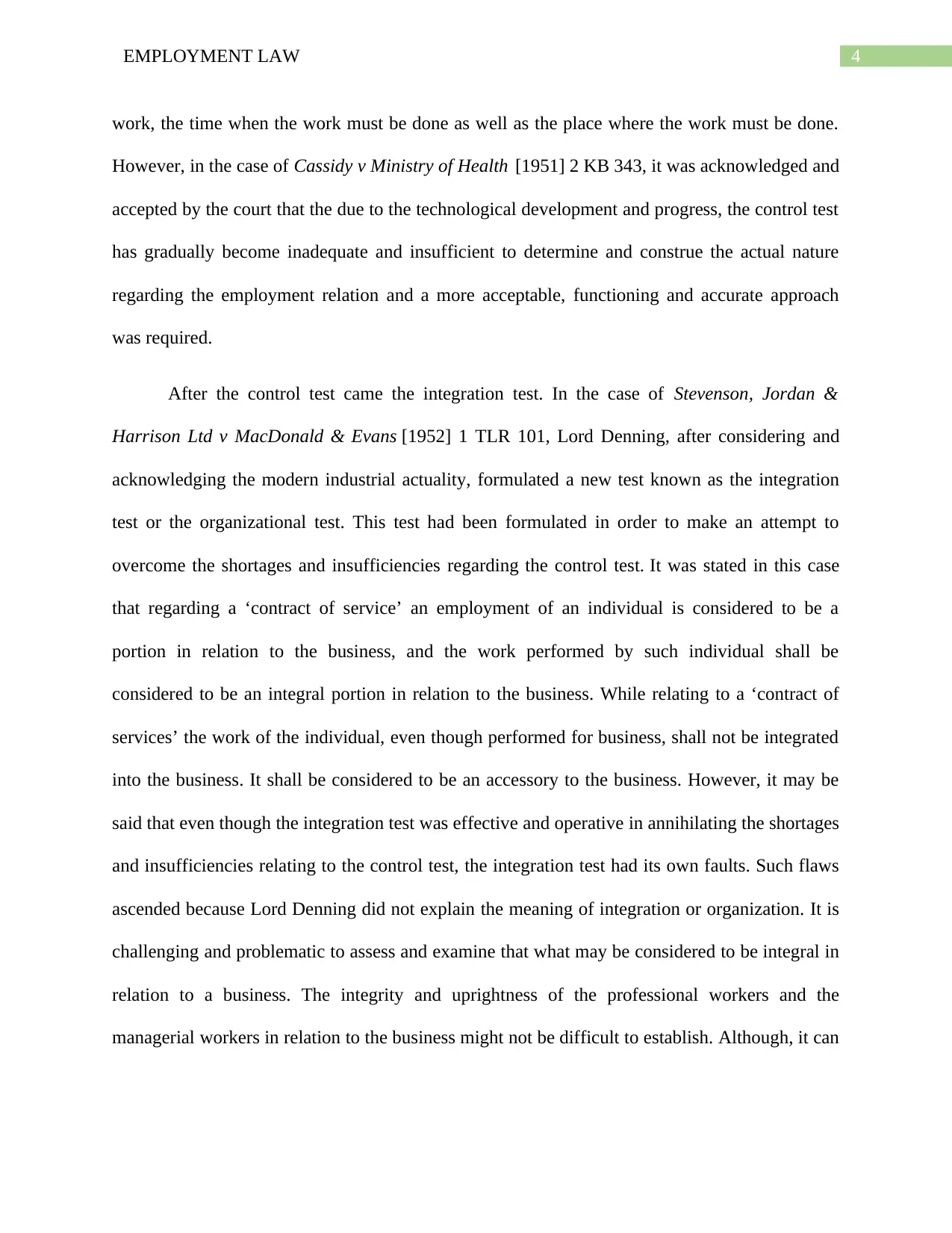
4EMPLOYMENT LAW
work, the time when the work must be done as well as the place where the work must be done.
However, in the case of Cassidy v Ministry of Health [1951] 2 KB 343, it was acknowledged and
accepted by the court that the due to the technological development and progress, the control test
has gradually become inadequate and insufficient to determine and construe the actual nature
regarding the employment relation and a more acceptable, functioning and accurate approach
was required.
After the control test came the integration test. In the case of Stevenson, Jordan &
Harrison Ltd v MacDonald & Evans [1952] 1 TLR 101, Lord Denning, after considering and
acknowledging the modern industrial actuality, formulated a new test known as the integration
test or the organizational test. This test had been formulated in order to make an attempt to
overcome the shortages and insufficiencies regarding the control test. It was stated in this case
that regarding a ‘contract of service’ an employment of an individual is considered to be a
portion in relation to the business, and the work performed by such individual shall be
considered to be an integral portion in relation to the business. While relating to a ‘contract of
services’ the work of the individual, even though performed for business, shall not be integrated
into the business. It shall be considered to be an accessory to the business. However, it may be
said that even though the integration test was effective and operative in annihilating the shortages
and insufficiencies relating to the control test, the integration test had its own faults. Such flaws
ascended because Lord Denning did not explain the meaning of integration or organization. It is
challenging and problematic to assess and examine that what may be considered to be integral in
relation to a business. The integrity and uprightness of the professional workers and the
managerial workers in relation to the business might not be difficult to establish. Although, it can
work, the time when the work must be done as well as the place where the work must be done.
However, in the case of Cassidy v Ministry of Health [1951] 2 KB 343, it was acknowledged and
accepted by the court that the due to the technological development and progress, the control test
has gradually become inadequate and insufficient to determine and construe the actual nature
regarding the employment relation and a more acceptable, functioning and accurate approach
was required.
After the control test came the integration test. In the case of Stevenson, Jordan &
Harrison Ltd v MacDonald & Evans [1952] 1 TLR 101, Lord Denning, after considering and
acknowledging the modern industrial actuality, formulated a new test known as the integration
test or the organizational test. This test had been formulated in order to make an attempt to
overcome the shortages and insufficiencies regarding the control test. It was stated in this case
that regarding a ‘contract of service’ an employment of an individual is considered to be a
portion in relation to the business, and the work performed by such individual shall be
considered to be an integral portion in relation to the business. While relating to a ‘contract of
services’ the work of the individual, even though performed for business, shall not be integrated
into the business. It shall be considered to be an accessory to the business. However, it may be
said that even though the integration test was effective and operative in annihilating the shortages
and insufficiencies relating to the control test, the integration test had its own faults. Such flaws
ascended because Lord Denning did not explain the meaning of integration or organization. It is
challenging and problematic to assess and examine that what may be considered to be integral in
relation to a business. The integrity and uprightness of the professional workers and the
managerial workers in relation to the business might not be difficult to establish. Although, it can
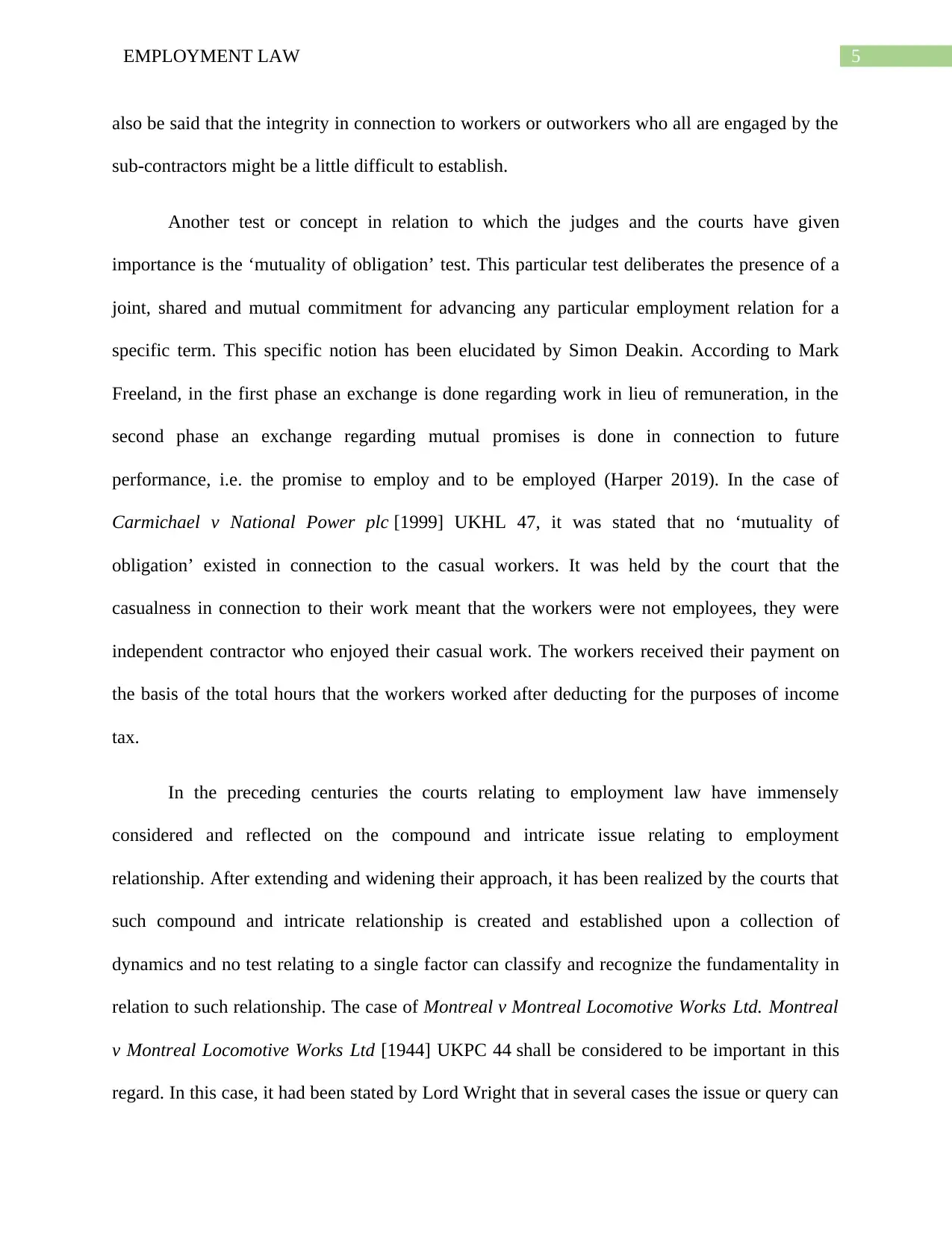
5EMPLOYMENT LAW
also be said that the integrity in connection to workers or outworkers who all are engaged by the
sub-contractors might be a little difficult to establish.
Another test or concept in relation to which the judges and the courts have given
importance is the ‘mutuality of obligation’ test. This particular test deliberates the presence of a
joint, shared and mutual commitment for advancing any particular employment relation for a
specific term. This specific notion has been elucidated by Simon Deakin. According to Mark
Freeland, in the first phase an exchange is done regarding work in lieu of remuneration, in the
second phase an exchange regarding mutual promises is done in connection to future
performance, i.e. the promise to employ and to be employed (Harper 2019). In the case of
Carmichael v National Power plc [1999] UKHL 47, it was stated that no ‘mutuality of
obligation’ existed in connection to the casual workers. It was held by the court that the
casualness in connection to their work meant that the workers were not employees, they were
independent contractor who enjoyed their casual work. The workers received their payment on
the basis of the total hours that the workers worked after deducting for the purposes of income
tax.
In the preceding centuries the courts relating to employment law have immensely
considered and reflected on the compound and intricate issue relating to employment
relationship. After extending and widening their approach, it has been realized by the courts that
such compound and intricate relationship is created and established upon a collection of
dynamics and no test relating to a single factor can classify and recognize the fundamentality in
relation to such relationship. The case of Montreal v Montreal Locomotive Works Ltd. Montreal
v Montreal Locomotive Works Ltd [1944] UKPC 44 shall be considered to be important in this
regard. In this case, it had been stated by Lord Wright that in several cases the issue or query can
also be said that the integrity in connection to workers or outworkers who all are engaged by the
sub-contractors might be a little difficult to establish.
Another test or concept in relation to which the judges and the courts have given
importance is the ‘mutuality of obligation’ test. This particular test deliberates the presence of a
joint, shared and mutual commitment for advancing any particular employment relation for a
specific term. This specific notion has been elucidated by Simon Deakin. According to Mark
Freeland, in the first phase an exchange is done regarding work in lieu of remuneration, in the
second phase an exchange regarding mutual promises is done in connection to future
performance, i.e. the promise to employ and to be employed (Harper 2019). In the case of
Carmichael v National Power plc [1999] UKHL 47, it was stated that no ‘mutuality of
obligation’ existed in connection to the casual workers. It was held by the court that the
casualness in connection to their work meant that the workers were not employees, they were
independent contractor who enjoyed their casual work. The workers received their payment on
the basis of the total hours that the workers worked after deducting for the purposes of income
tax.
In the preceding centuries the courts relating to employment law have immensely
considered and reflected on the compound and intricate issue relating to employment
relationship. After extending and widening their approach, it has been realized by the courts that
such compound and intricate relationship is created and established upon a collection of
dynamics and no test relating to a single factor can classify and recognize the fundamentality in
relation to such relationship. The case of Montreal v Montreal Locomotive Works Ltd. Montreal
v Montreal Locomotive Works Ltd [1944] UKPC 44 shall be considered to be important in this
regard. In this case, it had been stated by Lord Wright that in several cases the issue or query can
⊘ This is a preview!⊘
Do you want full access?
Subscribe today to unlock all pages.

Trusted by 1+ million students worldwide
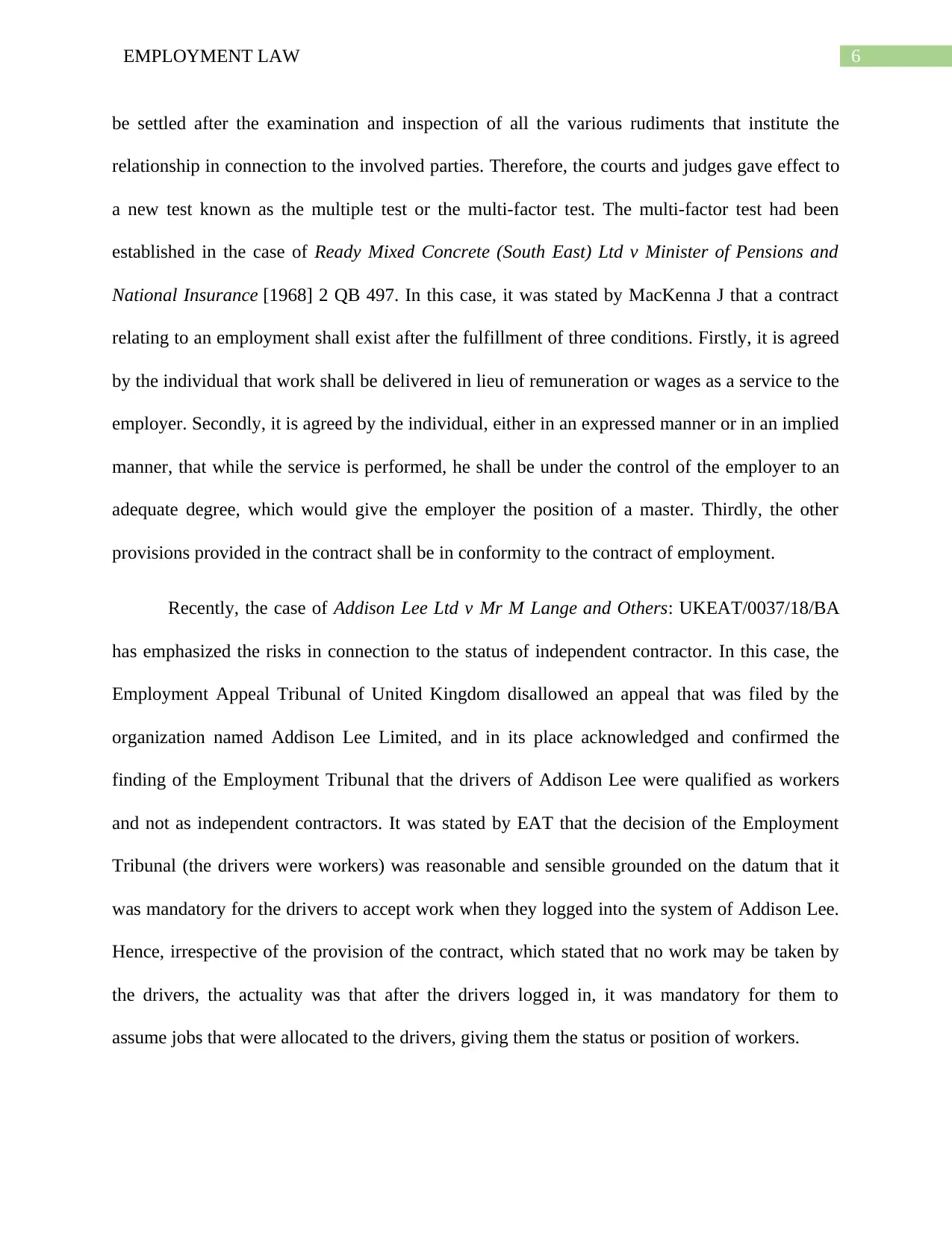
6EMPLOYMENT LAW
be settled after the examination and inspection of all the various rudiments that institute the
relationship in connection to the involved parties. Therefore, the courts and judges gave effect to
a new test known as the multiple test or the multi-factor test. The multi-factor test had been
established in the case of Ready Mixed Concrete (South East) Ltd v Minister of Pensions and
National Insurance [1968] 2 QB 497. In this case, it was stated by MacKenna J that a contract
relating to an employment shall exist after the fulfillment of three conditions. Firstly, it is agreed
by the individual that work shall be delivered in lieu of remuneration or wages as a service to the
employer. Secondly, it is agreed by the individual, either in an expressed manner or in an implied
manner, that while the service is performed, he shall be under the control of the employer to an
adequate degree, which would give the employer the position of a master. Thirdly, the other
provisions provided in the contract shall be in conformity to the contract of employment.
Recently, the case of Addison Lee Ltd v Mr M Lange and Others: UKEAT/0037/18/BA
has emphasized the risks in connection to the status of independent contractor. In this case, the
Employment Appeal Tribunal of United Kingdom disallowed an appeal that was filed by the
organization named Addison Lee Limited, and in its place acknowledged and confirmed the
finding of the Employment Tribunal that the drivers of Addison Lee were qualified as workers
and not as independent contractors. It was stated by EAT that the decision of the Employment
Tribunal (the drivers were workers) was reasonable and sensible grounded on the datum that it
was mandatory for the drivers to accept work when they logged into the system of Addison Lee.
Hence, irrespective of the provision of the contract, which stated that no work may be taken by
the drivers, the actuality was that after the drivers logged in, it was mandatory for them to
assume jobs that were allocated to the drivers, giving them the status or position of workers.
be settled after the examination and inspection of all the various rudiments that institute the
relationship in connection to the involved parties. Therefore, the courts and judges gave effect to
a new test known as the multiple test or the multi-factor test. The multi-factor test had been
established in the case of Ready Mixed Concrete (South East) Ltd v Minister of Pensions and
National Insurance [1968] 2 QB 497. In this case, it was stated by MacKenna J that a contract
relating to an employment shall exist after the fulfillment of three conditions. Firstly, it is agreed
by the individual that work shall be delivered in lieu of remuneration or wages as a service to the
employer. Secondly, it is agreed by the individual, either in an expressed manner or in an implied
manner, that while the service is performed, he shall be under the control of the employer to an
adequate degree, which would give the employer the position of a master. Thirdly, the other
provisions provided in the contract shall be in conformity to the contract of employment.
Recently, the case of Addison Lee Ltd v Mr M Lange and Others: UKEAT/0037/18/BA
has emphasized the risks in connection to the status of independent contractor. In this case, the
Employment Appeal Tribunal of United Kingdom disallowed an appeal that was filed by the
organization named Addison Lee Limited, and in its place acknowledged and confirmed the
finding of the Employment Tribunal that the drivers of Addison Lee were qualified as workers
and not as independent contractors. It was stated by EAT that the decision of the Employment
Tribunal (the drivers were workers) was reasonable and sensible grounded on the datum that it
was mandatory for the drivers to accept work when they logged into the system of Addison Lee.
Hence, irrespective of the provision of the contract, which stated that no work may be taken by
the drivers, the actuality was that after the drivers logged in, it was mandatory for them to
assume jobs that were allocated to the drivers, giving them the status or position of workers.
Paraphrase This Document
Need a fresh take? Get an instant paraphrase of this document with our AI Paraphraser
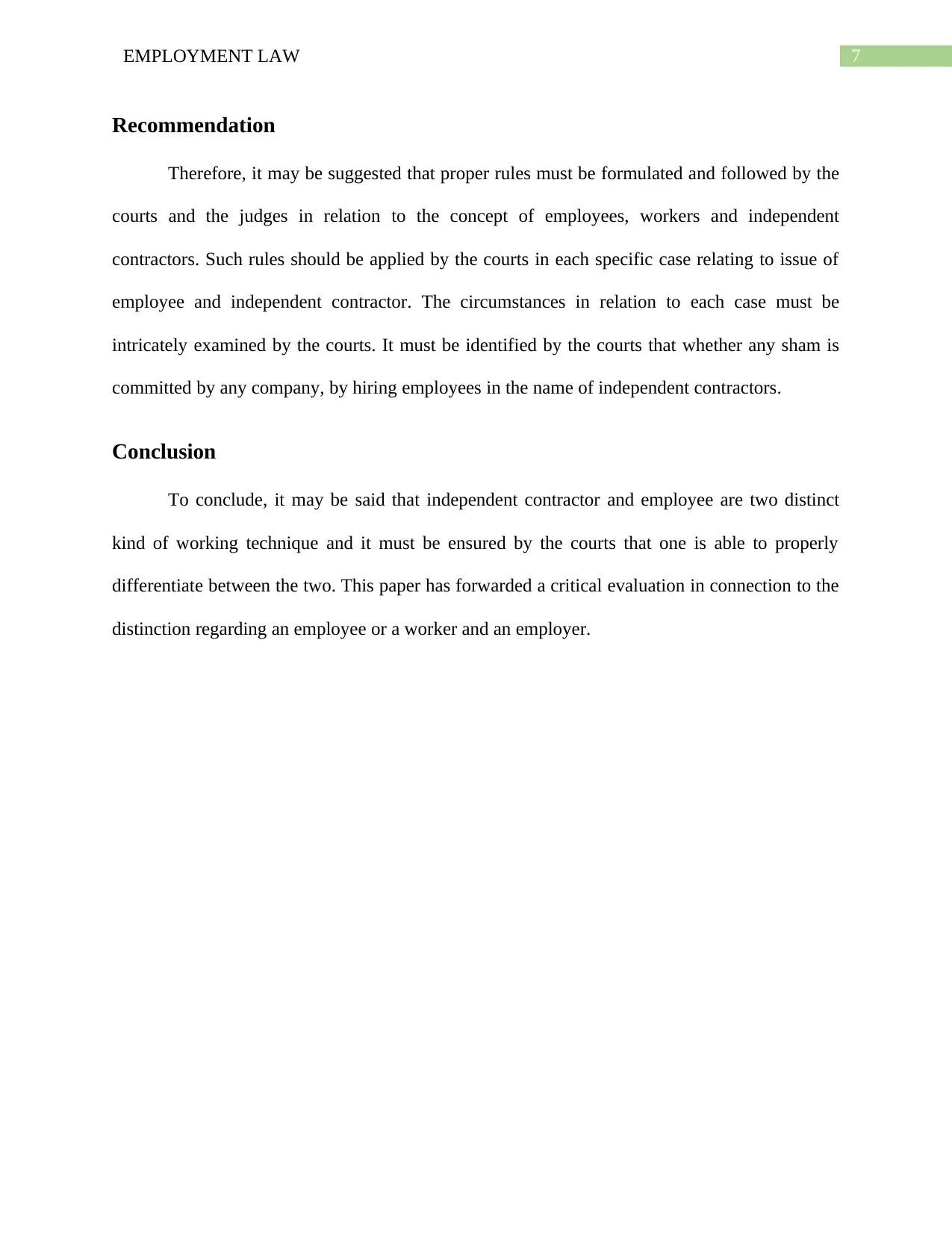
7EMPLOYMENT LAW
Recommendation
Therefore, it may be suggested that proper rules must be formulated and followed by the
courts and the judges in relation to the concept of employees, workers and independent
contractors. Such rules should be applied by the courts in each specific case relating to issue of
employee and independent contractor. The circumstances in relation to each case must be
intricately examined by the courts. It must be identified by the courts that whether any sham is
committed by any company, by hiring employees in the name of independent contractors.
Conclusion
To conclude, it may be said that independent contractor and employee are two distinct
kind of working technique and it must be ensured by the courts that one is able to properly
differentiate between the two. This paper has forwarded a critical evaluation in connection to the
distinction regarding an employee or a worker and an employer.
Recommendation
Therefore, it may be suggested that proper rules must be formulated and followed by the
courts and the judges in relation to the concept of employees, workers and independent
contractors. Such rules should be applied by the courts in each specific case relating to issue of
employee and independent contractor. The circumstances in relation to each case must be
intricately examined by the courts. It must be identified by the courts that whether any sham is
committed by any company, by hiring employees in the name of independent contractors.
Conclusion
To conclude, it may be said that independent contractor and employee are two distinct
kind of working technique and it must be ensured by the courts that one is able to properly
differentiate between the two. This paper has forwarded a critical evaluation in connection to the
distinction regarding an employee or a worker and an employer.
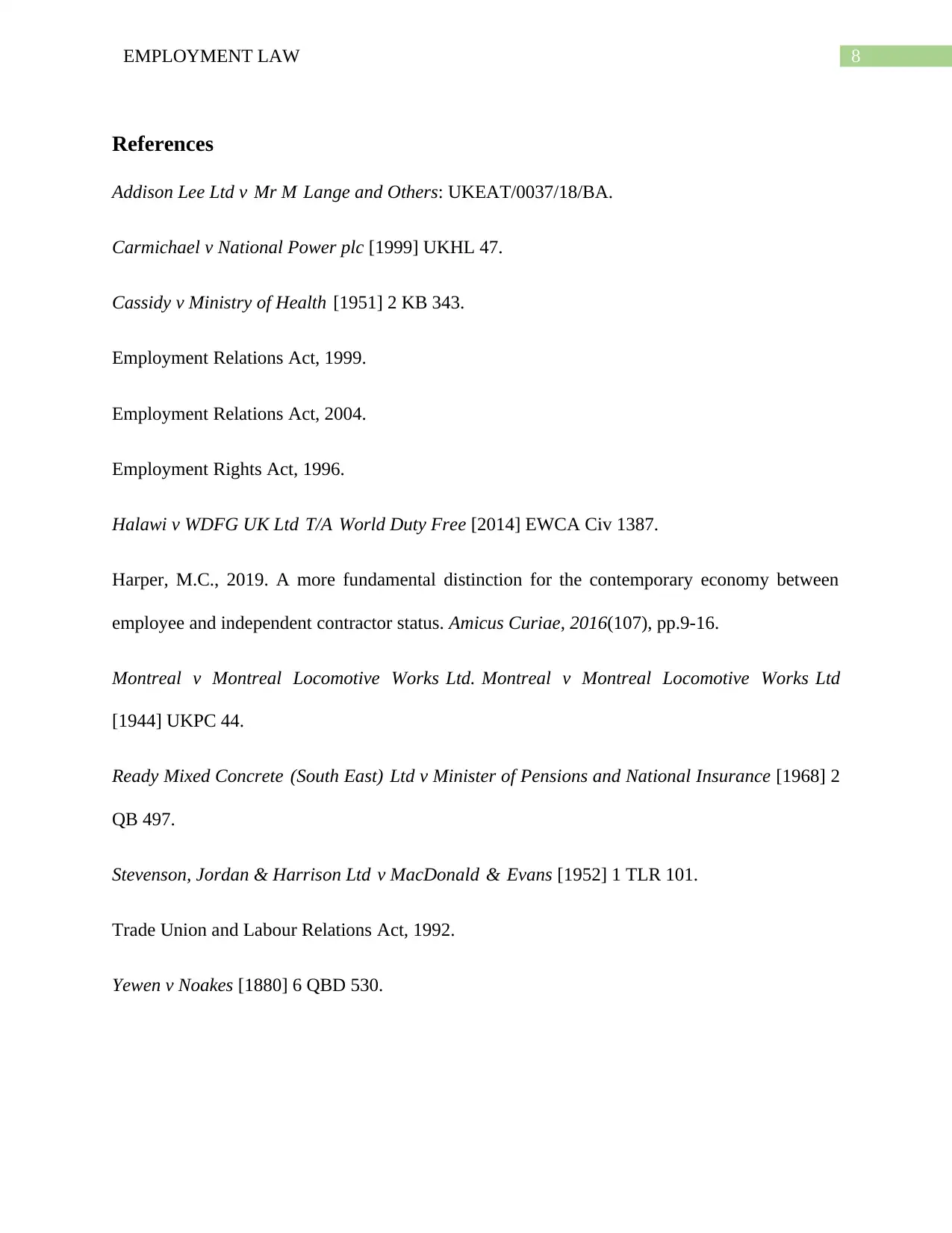
8EMPLOYMENT LAW
References
Addison Lee Ltd v Mr M Lange and Others: UKEAT/0037/18/BA.
Carmichael v National Power plc [1999] UKHL 47.
Cassidy v Ministry of Health [1951] 2 KB 343.
Employment Relations Act, 1999.
Employment Relations Act, 2004.
Employment Rights Act, 1996.
Halawi v WDFG UK Ltd T/A World Duty Free [2014] EWCA Civ 1387.
Harper, M.C., 2019. A more fundamental distinction for the contemporary economy between
employee and independent contractor status. Amicus Curiae, 2016(107), pp.9-16.
Montreal v Montreal Locomotive Works Ltd. Montreal v Montreal Locomotive Works Ltd
[1944] UKPC 44.
Ready Mixed Concrete (South East) Ltd v Minister of Pensions and National Insurance [1968] 2
QB 497.
Stevenson, Jordan & Harrison Ltd v MacDonald & Evans [1952] 1 TLR 101.
Trade Union and Labour Relations Act, 1992.
Yewen v Noakes [1880] 6 QBD 530.
References
Addison Lee Ltd v Mr M Lange and Others: UKEAT/0037/18/BA.
Carmichael v National Power plc [1999] UKHL 47.
Cassidy v Ministry of Health [1951] 2 KB 343.
Employment Relations Act, 1999.
Employment Relations Act, 2004.
Employment Rights Act, 1996.
Halawi v WDFG UK Ltd T/A World Duty Free [2014] EWCA Civ 1387.
Harper, M.C., 2019. A more fundamental distinction for the contemporary economy between
employee and independent contractor status. Amicus Curiae, 2016(107), pp.9-16.
Montreal v Montreal Locomotive Works Ltd. Montreal v Montreal Locomotive Works Ltd
[1944] UKPC 44.
Ready Mixed Concrete (South East) Ltd v Minister of Pensions and National Insurance [1968] 2
QB 497.
Stevenson, Jordan & Harrison Ltd v MacDonald & Evans [1952] 1 TLR 101.
Trade Union and Labour Relations Act, 1992.
Yewen v Noakes [1880] 6 QBD 530.
⊘ This is a preview!⊘
Do you want full access?
Subscribe today to unlock all pages.

Trusted by 1+ million students worldwide
1 out of 9
Related Documents
Your All-in-One AI-Powered Toolkit for Academic Success.
+13062052269
info@desklib.com
Available 24*7 on WhatsApp / Email
![[object Object]](/_next/static/media/star-bottom.7253800d.svg)
Unlock your academic potential
Copyright © 2020–2025 A2Z Services. All Rights Reserved. Developed and managed by ZUCOL.





